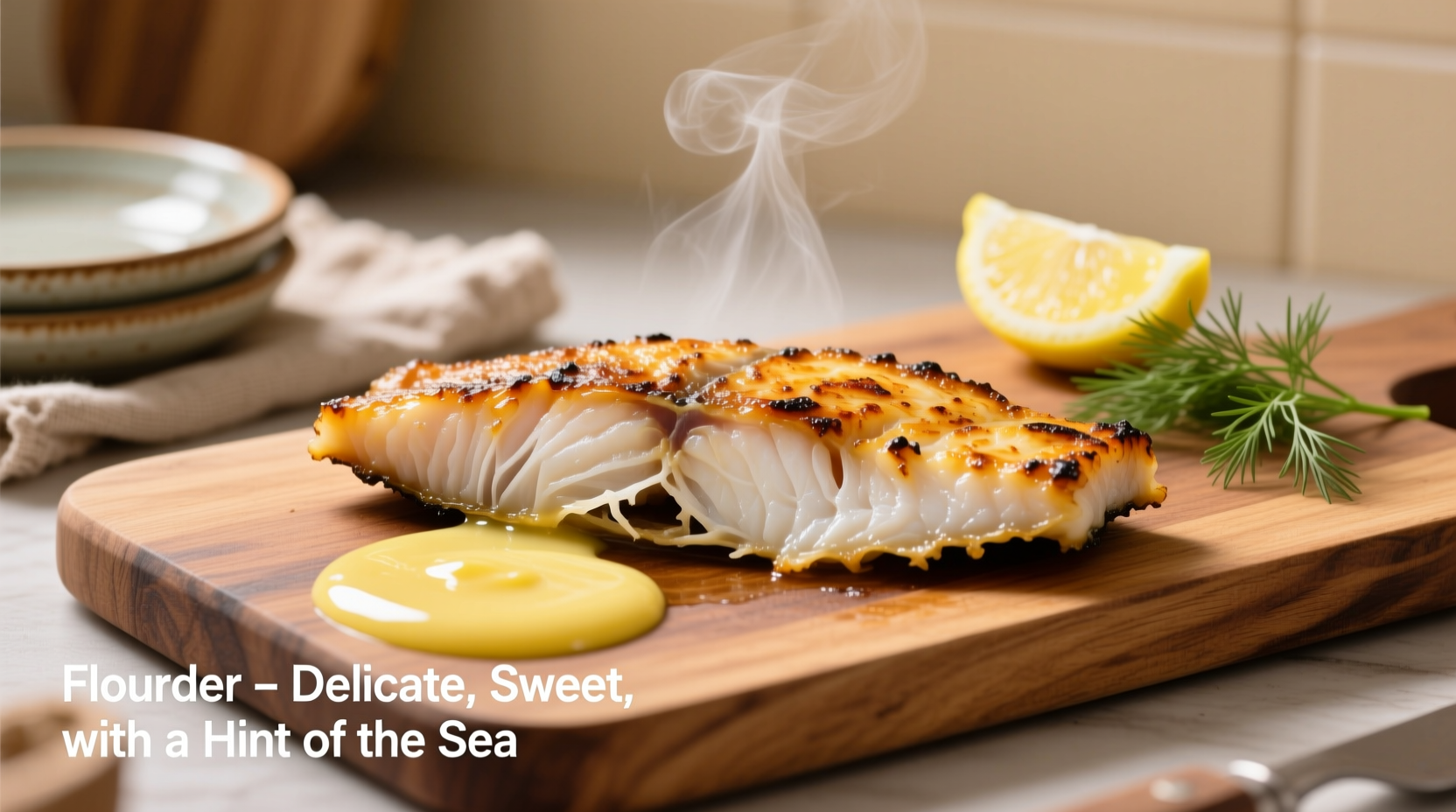When you're standing at the seafood counter wondering what does flounder taste like, you're probably looking for more than just "fishy" or "not fishy." Understanding flounder's distinctive flavor profile helps you make informed choices for your next meal, whether you're a seafood novice or an experienced home cook expanding your repertoire.
Understanding Flounder's Culinary Identity
Flounder belongs to the flatfish family, which includes halibut, sole, and turbot. Unlike its larger cousin halibut, flounder maintains a consistently mild character throughout its flesh. The flounder taste characteristics stem from its lean composition and habitat—these bottom-dwellers feed on small crustaceans and mollusks in sandy coastal waters, contributing to their clean, non-oily flavor.
According to the U.S. Food and Drug Administration's Seafood Guidelines, flounder's mild flavor profile makes it an excellent introduction to seafood for children and those with sensitive palates. Its subtle taste doesn't require strong seasonings to be enjoyable, though it responds beautifully to thoughtful enhancements.
Flounder vs. Other White Fish: A Flavor Comparison
| Fish Variety | Flavor Intensity | Texture | Best Cooking Methods |
|---|---|---|---|
| Flounder | Mild, slightly sweet | Tender with delicate flakes | Pan-searing, baking, poaching |
| Cod | Mild, clean | Firm, large flakes | Baking, grilling, frying |
| Haddock | Mild, slightly sweet | Firm, meaty | Frying, baking, smoking |
| Sole | Very mild | Extremely delicate | Pan-frying, sautéing |
This flounder vs cod taste comparison reveals why chefs often substitute flounder when a recipe calls for sole—it offers similar delicacy with slightly more substance. While cod provides larger, meatier flakes, flounder's thinner fillets cook more quickly and absorb flavors more readily.
Factors That Influence Flounder's Flavor Profile
Several elements affect what does flounder taste like in your final dish:
- Freshness: Fresh flounder should smell like the ocean—not fishy. The flesh should be translucent and spring back when pressed. As noted by the National Oceanic and Atmospheric Administration's Seafood Selector, flounder loses quality rapidly after harvest, with flavor diminishing noticeably after 48 hours.
- Cooking method: High-heat methods like pan-searing create a delicate crust that enhances natural sweetness, while poaching preserves its subtle flavor.
- Seasonal variations: Summer-caught flounder tends to be slightly sweeter as the fish feed more actively.
- Geographic origin: Atlantic flounder often has a slightly sweeter profile than Pacific varieties.

Maximizing Flounder's Natural Flavor
Professional chefs at the Culinary Institute of America emphasize that how to cook flounder to enhance flavor requires understanding its delicate nature. Unlike oilier fish that stand up to bold flavors, flounder benefits from complementary rather than competing elements.
"Flounder's subtle sweetness shines with citrus accents and fresh herbs," explains Antonio Rodriguez, chef and seafood specialist. "A squeeze of lemon isn't just traditional—it actually enhances the natural sugars in the fish through acid interaction. For best results, add lemon juice after cooking to preserve the delicate flavor compounds that heat would otherwise break down."
Consider these flavor pairings that work exceptionally well with flounder's profile:
- Citrus elements: Lemon, lime, or orange zest (added after cooking)
- Fresh herbs: Dill, parsley, chives, or tarragon
- Light sauces: Beurre blanc, lemon-caper butter, or light tomato broths
- Aromatics: Shallots, garlic (used sparingly), and fennel
Common Flavor Pitfalls to Avoid
Understanding why does flounder taste the way it does helps avoid common preparation mistakes. Flounder's lean composition means it dries out quickly when overcooked—a critical consideration since its mild flavor won't mask texture issues.
The USDA Food Safety and Inspection Service recommends cooking flounder to an internal temperature of 145°F (63°C), at which point the flesh becomes opaque and flakes easily. Exceeding this temperature by just 5-10 degrees can transform tender flounder into dry, stringy meat that loses its delicate flavor profile.
Additionally, avoid:
- Overpowering marinades (acidic components can "cook" the delicate flesh)
- Excessive salt before cooking (draws out moisture)
- Strongly flavored oils (like extra virgin olive oil) that compete with the fish's subtlety
Seasonal Availability and Flavor Implications
Flounder's flavor profile varies slightly throughout the year based on feeding patterns and water temperatures. Understanding these fresh flounder taste characteristics by season helps optimize your cooking:
- Spring (March-May): Leaner profile as fish emerge from winter; ideal for delicate preparations
- Summer (June-August): Sweetest flavor as feeding increases; perfect for simple preparations
- Fall (September-November): Richer texture as fish prepare for winter; handles bolder seasonings
- Winter (December-February): Most delicate flavor; best with minimal preparation
According to fisheries data from the NOAA Northeast Fisheries Science Center, summer-caught flounder shows approximately 15% higher natural sugar content, explaining its slightly sweeter taste profile during warmer months.
Practical Applications for Home Cooks
When working with flounder, remember these practical tips that address the core question of is flounder a mild tasting fish:
- Thickness matters: Thinner fillets (common with flounder) cook in 3-4 minutes per side, while thicker cuts need 6-8 minutes
- Skin considerations: Flounder skin is delicate and often removed before cooking; if keeping skin on, score it to prevent curling
- Flavor absorption: Marinate for no more than 30 minutes to avoid texture changes
- Leftover potential: Flounder doesn't reheat well; plan portions carefully
For those exploring best seasonings for flounder, consider a simple preparation that highlights rather than masks its natural flavor: pat fillets dry, season lightly with sea salt, pan-sear in clarified butter until golden, then finish with fresh lemon juice and chopped parsley. This method preserves the delicate flavor while enhancing its natural sweetness.











 浙公网安备
33010002000092号
浙公网安备
33010002000092号 浙B2-20120091-4
浙B2-20120091-4